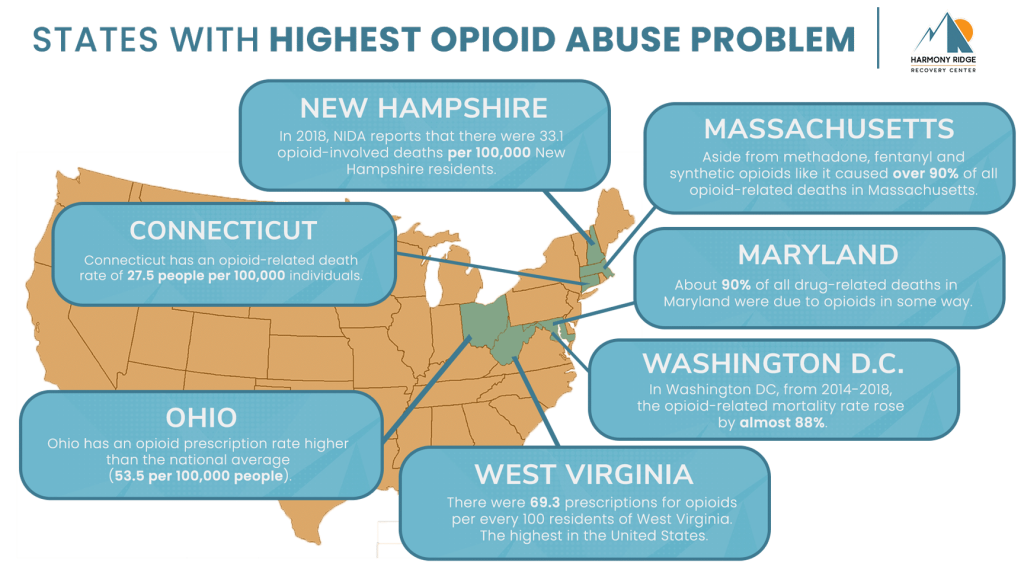
In the 90s, the pharmacology industry came out with an alternative to barbiturates: prescription opioids. This class of drugs was said to be less addictive than barbiturates and still help individuals with severe pain. Despite the pharmaceutical industry’s reassurance that prescription opioids were not addictive, the medical community found this to be untrue.
As a result, many individuals have become addicted to opioids. With this, illegal opioids, like heroin, threaten the livelihood of Americans nationwide. However, some states have been affected more than others. Opioid-related deaths have ravaged multiple states, making them the states with the highest opioid abuse rates. Fortunately, opioid and opiate addiction rehab centers like Harmony Ridge can help individuals avoid overdose as well as overcome addiction.
What Are the States With Highest Opioid Abuse Rates?
This list is in order from states with the highest opioid abuse rates to the lowest (among the seven, not overall):
- West Virginia
- Maryland
- New Hampshire
- Ohio
- Massachusetts
- Connecticut
- Washington D.C.
Top 7 States With Highest Opioid Abuse Rates
1. West Virginia

According to the most recent data from the National Institute on Drug Abuse (NIDA), West Virginia is the state with the highest opioid abuse. Although it’s not the state with the highest rate of prescriptions for opioids, it’s still significantly higher than the national average. There were 69.3 prescriptions for opioids per every 100 residents of West Virginia.
This may be due to the fact that a large portion of West Virginians have jobs that involve hard, physical labor. Some of these occupations range from timbering to manufacturing. When individuals seek out prescription opioids to ease chronic pain from work-related injuries, they may become addicted in the process.
Once addicted, West Virginians may then make the switch from controlled prescription drug misuse to heroin misuse due to the fact that heroin is much less expensive and doesn’t require a prescription to get. For this reason, it’s important for opioid misusers in West Virginia to seek out an opiate addiction rehab center as soon as they feel that they’re unable to stop using prescription opioids.
2. Maryland
Also on the east coast, Maryland is another state with an opioid crisis. Yet, it’s different from West Virginia in that the rate of prescriptions for opioids there is less than the national average.
In 2018, medical professionals prescribed 45.1 opioid prescriptions per 100 people. In comparison, the national average is 51.4 prescriptions for opioids per 100 people. Despite this, Maryland is still the second state with the highest opioid abuse in the nation.
While the number of prescriptions doled out in Maryland may not reflect its high rates of opioid misuse, the mortality rate in Maryland does. About 90% of all drug-related deaths in Maryland were due to opioids in some way. Fentanyl is a synthetic opioid that has specifically hurt many people in Maryland.
3. New Hampshire

In New Hampshire, there is a rate of 46.1 opioid prescriptions prescribed per 100 people. Since the national average of prescription opioids that are prescribed is 51.4 per 100 people, the New Hampshire rate of prescribed opioids is about 11% lower than the United States rate as a whole. Even so, New Hampshire is one of the states with the highest opioid abuse rates as seen by the amount of death due to this kind of drug.
In 2018, NIDA reports that there were 33.1 opioid-involved deaths per 100,000 New Hampshire residents. Unfortunately, the rate of opioid-involved deaths hasn’t significantly decreased over time. Yet, the amount of deaths related to prescription opioids has. For instance, there were 89 opioid-related deaths in 2016, but only 43 opioid-related deaths in 2018. The New Hampshire opioid-related death rate went from 6.5 to a rate of 3.1 (more than half).
4. Ohio
Ohio is the fourth-worst state in terms of opioid abuse. When a state experiences a spike in opioid abuse, everyone suffers. But pregnant women and their unborn babies suffer in particular. Neonatal Abstinence Syndrome (NAS), or Neonatal Opioid Withdrawal Syndrome (NOWS), is known to occur when a mother uses opioids during pregnancy. In Ohio, there were 11.6 cases of NAS/NOWS per 1,000 births.
When a baby is born after a mother consumes opioids during pregnancy, the newborn may experience withdrawal symptoms. Babies with NAS may be overly irritable in the short term but may experience much deeper health complications in the long term. Some of these include stunted cognitive development as well as visual problems.
With this, Ohio has an opioid prescription rate higher than the national average (53.5 per 100,000 people). This may have lead to the high amount of opioid-related deaths reported in 2018. There were 29.6 opioid-related deaths per 100,000 individuals.
5. Massachusetts
Out of the top 7 states with highest opioid abuse rates, Massachusetts is number five. This state’s rate of opioid prescriptions per 100,000 people is 35.3. This is much lower than the national average of 51.4 prescriptions per 100,000 people. In fact, it’s one of the lowest prescribing rates in the country.
However, there is still a high rate of opioid-related deaths in Massachusetts. In fact, around 29 per 100,000 people in this state die because of an opioid overdose.
This high opioid-based mortality rate is due to the fact that Massachusetts’s low prescribing rate of opioids doesn’t stop people from consuming other kinds of opioids illegally. Aside from methadone, fentanyl and synthetic opioids like it caused over 90% of all opioid-related deaths in this state.
6. Connecticut
Connecticut has a lower prescribing rate for prescription opioids, yet still has a higher opioid-related mortality rate than the rest of the nation. For example, the mean of opioid-related deaths in the United States overall is 14.98 deaths per 10,000 Americans. In comparison, Connecticut has an opioid-related death rate of 27.5 people per 100,000 individuals.
Research from Preventive Medicine Reports writes that opioid-related deaths may be due to the cost of prescription medications. People without insurance for medicine may opt to use an illegal opioid to deal with physical pain.
Recent data shows that over 73% of Americans without insurance say they don’t have it because it’s too expensive to afford. Ultimately, this journal states that this isn’t definite and they’re not completely sure as to why some states have much worse opioid abuse issues than others.
7. Washington D.C.
Ironically, the nation’s capital is one of the places that has been affected the most by the opioid epidemic. Although it’s not technically a state, it’s an entity of its own, instead of a city within a particular state. Like Connecticut, Washington D.C. has a low rate of opioid prescriptions. Yet, similar to Connecticut, it has a higher rate of opioid-related deaths than the nation overall. This state has an opioid overdose mortality rate of 26.7 per 100,000 people.
From 2014-2018, the opioid-related mortality rate rose by almost 88%. However, from 2017-2018 it lowered back down by almost 28%.
Washington D.C. has a public-private organization whose sole purpose is to reduce the rate of opioid abuse in the area. This organization found that a large number of opioid-related deaths is due to the fact that dealers will cut heroin with deadly fentanyl. Those who don’t know it’s cut with fentanyl can easily die as a result.
What Are Opioids?

Opioids are a type of drug that acts as a central nervous system depressant. Drugs in this class work by blocking opioid receptors found in the brain. These kinds of receptors are nerve cells that send messages between the brain and body to regulate pain and pleasure.
When opioids block these receptors, it diminishes pain and creates a flush of dopamine (a chemical associated with reward-seeking behavior and pleasure).
On one hand, this helps people diminish pain when they really need it most. On the other hand, it can be quite addictive because of the influx of dopamine that it causes. Understanding the danger behind it can help individuals avoid becoming addicted to them.
Types of Opioids
- Heroin
- Fentanyl
- Methadone
- Hydrocodone
- Oxycodone
- Codeine
- Morphine
What Are Opiates?
Opiates are types of opioids that are derived naturally from the poppy plant. Opioids can encompass every type of opioid, whether it’s natural, synthetic, or semi-synthetic. So, an opiate can be a form of opioid, but it’s not the other way around in all cases. Thus, there is overlap between types of opioids and types of opiates.
Types of Opiates
- Morphine
- Opium
- Codeine
- Thebaine
Opioid and Opiate Addiction Rehab Center

The facts show that it’s necessary to attend an opioid or opiate addiction rehab center when suffering from an addiction to these kinds of drugs. While some may feel embarrassed to admit that they’re struggling with a substance use disorder, such people should understand that addiction isn’t a choice. It’s a complex medical condition that needs medical assistance—and quickly.
There are various types of treatments available for those suffering from a substance use disorder. Each has its own benefits and might suit one individual more than another.
Detox
Those suffering from an opioid addiction must first rid their body of all traces of opioids before they receive treatment. Patients undergoing detox at an opioid and opiate addiction rehab center will be under 24/7 medical supervision to make sure that they don’t have any severe withdrawal symptoms. Skipping this step will likely lead to relapse, which can easily result in death.
Medication-Assisted Treatment
Medication-assisted treatment, or MAT, can help individuals overcome an opioid addiction comfortably and safely. If an individual is having an opioid overdose, a medical professional will likely prescribe naloxone to reverse the overdose.
Other medications may be used to help deal with opioid withdrawal symptoms or any underlying issues that have led patients to abuse opioids. Naltrexone is one that is commonly used to help those with an opioid addiction.
Inpatient and Outpatient Treatment
Patients can choose between a treatment program where they can live at the facility (inpatient) or one that lets them live outside the opioid addiction treatment facility (outpatient).
There are various levels of care within inpatient and outpatient programs. Yet, opioid addictions are difficult to overcome without serious treatment. Thus, inpatient care would likely be the most beneficial for individuals suffering from an opioid use disorder.
We’re an Accredited Opioid and Opiate Addiction Rehab Center in WV
Here at Harmony Ridge Recovery Center, we’re committed to helping individuals overcome any substance use disorder, including opioid use disorders. Our evidence-based treatments make us one of the leading addiction treatment centers in the area. We’re able to provide quality care for those with an opioid addiction from start to finish. Contact us now to see what program would fit you or a loved one best.
References:
- https://www.drugabuse.gov/publications/drugfacts/prescription-opioids
- https://www.drugabuse.gov/drug-topics/opioids/opioid-summaries-by-state
- https://www.marchofdimes.org/complications/neonatal-abstinence-syndrome-(nas).aspx
- https://www.ncbi.nlm.nih.gov/pmc/articles/PMC7516293/
- https://www.kff.org/uninsured/issue-brief/key-facts-about-the-uninsured-population/
- https://livelong.dc.gov/page/faqs-opioid
- https://livelong.dc.gov/sites/default/files/dc/sites/opioid/page_content/attachments/SLIDES-METRIC-DFS-FCU.pdf



